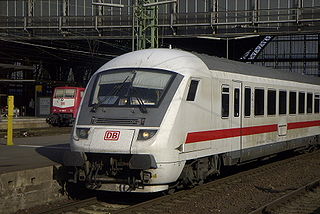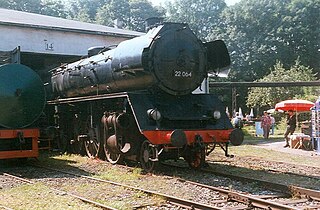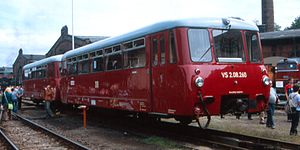
A railbus is a lightweight passenger railcar that shares many aspects of its construction with a bus, typically having a bus body and four wheels on a fixed base, instead of on bogies. Originally designed and developed during the 1930s, railbuses have evolved into larger dimensions, with characteristics similar in appearance to a light railcar, with the terms railcar and railbus often used interchangeably. Railbuses designed for use specifically on little-used railway lines were commonly employed in countries such as Germany, Italy, France, the United Kingdom and Sweden.
The different railway companies in Germany have used various schemes to classify their rolling stock.

The Prussian state railways' Class P 10 were 2-8-2 "Mikado" type passenger-hauling steam locomotives built for hauling heavy express trains in the hilly terrain of the Mittelgebirge. They were the last Prussian passenger train steam locomotives to be developed in Prussia before the state railways were merged into the Deutsche Reichsbahn, who eventually designated them as DRG Class 39.

The DRG Class SVT 877Hamburg Flyer – sometimes also Flying Hamburger or in German Fliegender Hamburger – was Germany's first fast diesel train, and is credited with establishing the fastest regular railway connection in the world in its time. Correctly named the Baureihe SVT 877, the diesel-electric powered train was used to carry passengers on the Berlin–Hamburg line. It entered service in 1933.

A control car, cab car, control trailer, or driving trailer is a non-powered rail vehicle from which a train can be operated. As dedicated vehicles or regular passenger cars, they have one or two driver compartments with all the controls and gauges required to remotely operate the locomotive, including exterior locomotive equipment such as horns, bells, ploughs, and lights. They also have communications and safety systems such as GSM-R or European Train Control System (ETCS). Control cars enable push-pull operation when located on the end of a train opposite its locomotive by allowing the train to reverse direction at a terminus without moving the locomotive or turning the train around.
The VT 10.5 was a diesel multiple unit that was developed by the Deutsche Bundesbahn in the early 1950s. It was first displayed in public at the International Transport Exhibition in Munich in 1953.

The Class 03 steam engines were standard express train locomotives (Einheitslokomotiven) in service with the Deutsche Reichsbahn.
The DRG locomotive classification system was developed by the German Imperial Railway Company or Deutsche Reichsbahn-Gesellschaft (DRG), which was formed in 1924 following the merger of the German state railways (Länderbahnen) in 1920. A common classification and numbering scheme was needed in order to organise effectively the four hundred or so different steam locomotive classes taken over from the state railways, as well as new locomotives. This process lasted until 1926. Only then was the final renumbering plan fixed.

The DR locomotive classification scheme in East Germany in the initial post-war period used the DRG system, consisting of a class number (Baureihennummer) followed by a serial number (Ordnungsnummer). With the introduction of computerised (EDP) numbers in 1970 as part of the UIC framework, the system was fundamentally changed for the first time.

The 'Hanover version' of the Wismar railbus was developed in the early 1930s as a light railbus for economical passenger services on branch lines in Germany.

The steam locomotives of DR Class 22 were reconstructed passenger train locomotives in service with the Deutsche Reichsbahn in East Germany after the Second World War.

The Henschel-Wegmann Train was an advanced passenger express train operated by the Deutsche Reichsbahn in Germany, which ran non-stop express services between Berlin and Dresden from June 1936 to August 1939. Both the DRG Class 61 steam locomotive at its head as well as the coaches were streamlined.

The DB Class 628 is a twin-car, diesel multiple unit operated by the Deutsche Bahn for local passenger rail services.

The DBAG Class 474/874 is a three-car electric multiple unit train for the Hamburg S-Bahn. The class 474 were built to replace the nearly-60-year-old class 471 trains. Some units have a pantograph (474.3) to service the 2007 opened line to Stade on an overhead catenary track.

The Córas Iompair Éireann (CIÉ) 2600 Class were Associated Equipment Company (AEC)–engined diesel multiple units that operated InterCity and suburban services on the CIÉ system between 1952 and 1975. Many were later converted for push–pull operation with diesel locomotives, finally being withdrawn when displaced by the electric Dublin Area Rapid Transit service in the mid-1980s.

The electric passenger train locomotives of Bavarian Class EP 3/5 were the first electric locomotives designed for single-phase AC, 15 kV, 16+2⁄3 Hz working for the Royal Bavarian State Railways. The first electrical services in Bavaria were on the Murnau–Oberammergau line using 5 kV and 16 Hz on 1 January 1905. After 1918 they were reclassified as EP1 20 001 – 005 and taken over by the DR as E 62 01 – 05.

EW51 was a three-car electric multiple unit, produced by the Lilpop, Rau i Loewenstein plants in Warsaw, H. Cegielski Spółka Akcyjna in Poznań and L. Zieleniewski in Sanok in the years 1936–1939. Electrical equipment was supplied by English Electric. The units were intended for suburban traffic in the Warsaw area. Before the war, the units had second- and third-class compartments. A total of 76 units were produced. Currently, the only surviving vehicle, EW51-36, is the property of the Museum Station in Warsaw. Restoration was completed in January 2019.

The BVG Class C was a series of Grossprofil cars used on the Berlin U-Bahn after 1926. In comparison to the previously built Class B, these 18 meter long cars were about five meters longer than their predecessors. They were therefore classified as Langwagen.
The DB Class 670 is a double-decker diesel railbus. It was created on request of the Deutsche Bahn by the Dessau and Halle-Ammendorf factories of the Deutsche Waggonbau AG (DWA) It has two axles and the construction re-used motorbus components.

The DR Class V 180 of Deutsche Reichsbahn was a class of the largest diesel locomotives built in the German Democratic Republic. The manufacturer was Lokomotivbau Karl Marx Babelsberg (LKM).



















